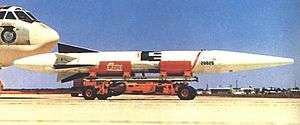Air-launched ballistic missile
An air-launched ballistic missile or ALBM is a ballistic missile launched from an aircraft. An ALBM allows the launch aircraft to stand off at long distances from its target, keeping it well outside the range of defensive weapons like anti-aircraft missiles and interceptor aircraft. Once launched, the missile is essentially immune to interception. This combination of features allowed a strategic bomber to present a credible deterrent second-strike option in an era when improving anti-aircraft defences appeared to be rendering conventional bombers obsolete.
The ALBM concept was studied in the US as a way to ensure the usefulness and survivability of their large bomber fleet. After testing several experimental designs as part of the WS-199 efforts, the USAF began development of the GAM-87 Skybolt missile with range on the order of 1,150 miles (1,850 km). The only other major force relying on strategic bombers was the Royal Air Force, who also selected the Skybolt to arm their V bomber fleet. The Soviet Union moved their strategic force directly to ICBMs.
Skybolt ultimately failed several key tests, while the US Navy's UGM-27 Polaris offered the same advantages and more. Skybolt was cancelled, leading to the Skybolt crisis and an agreement to sell Polaris to the Royal Navy as part of the Nassau Agreement. The concept saw little active development until the 1970s when ICBM warheads began to become accurate enough to attack other ICBMs while they were still on the ground. The US carried out several experiments using existing missile designs dropped from cargo aircraft, but ultimately abandoned this line of research entirely. No further strategic ALBM development has been carried out, and this class of missile never saw active use.
High Virgo
WS-199B Bold Orion
Developed by Martin Aircraft, the Bold Orion missile was an air-launched ballistic missile, launched from the B-47 Stratojet medium bomber, with flight tests being carried out in 1958 and 1959. Early launches of the Bold Orion as a single-stage vehicle were unsuccessful, however a redesign as a two-stage weapon produced improved results, with the remainder of the 12-launch series establishing the ALBM as a viable vehicle. The final test flight trialed the Bold Orion missile as an anti-satellite missile, passing within 4 miles (6.4 km) of Explorer VI,Parsch, Andreas (2005). "WS-199". Directory of U.S. Military Rockets and Missiles. designation-systems.net. Retrieved 2010-12-29. the first-ever interception of a satellite.[1]
GAM-87 Skybolt
The GAM-87 Skybolt, intended to be launched from Boeing B-52 Stratofortress and Avro Vulcan bombers, was in development by the United States Air Force, with the United Kingdom as a customer. In 1962, with technical difficulties and costs mounting, the program was cancelled, with the United States and the UK concentrating on the UGM-27 Polaris submarine-launched ballistic missile instead.
Air Mobile Feasibility test: C-5 w/ LGM-30
.jpg)
In the early 1970s, the USAF tested air-launching a Minuteman 1b ICBM from a C-5A Galaxy transport aircraft. On 24 October 1974, the Space and Missile Systems Organization successfully conducted an Air Mobile Feasibility test where a C-5A Galaxy aircraft air-dropped the 86,000-pound missile from 20,000 feet over the Pacific Ocean. The missile fell to 8,000 feet before its rocket engine fired. The 10-second engine burn carried the missile to 20,000 feet again before it dropped into the ocean. The test proved the feasibility of launching an intercontinental ballistic missile from the air. Operational deployment was discarded due to engineering and security difficulties, though the capability was used as a negotiating point in the Strategic Arms Limitation Talks.[2][3]
Kh-47M2 Kinzhal
In 2018, Russia unveiled an air-launched ballistic missile called Kh-47M2 Kinzhal with a range of 2,000 km (1,200 mi). It is suspected to be a version of the Iskander missile. Earlier Soviet aero-ballistic missiles have a much shorter range, e.g. Kh-15 only has a range of 300 km (190 mi).
Chinese programs
Defense Intelligence Agency chief Robert Ashley confirmed that China is developing two new air-launched ballistic missiles, one of which can carry a nuclear warhead.[4][5] The H-6K bomber would be suited to launch such missiles. One of these missiles is a derivative of the DF-21 called the CH-AS-X-13 and has a range of 3000km.
Air-launched ballistic training missiles
The Israeli Sparrow target missile is used to test the Arrow anti-ballistic missile system.[6]
See also
References
- Peebles 1997, p. 65.
- U.S. Air Force, Inside the AF.MIL Heritage section (Thursday, January 01, 1970 - Sunday, December 31, 1989) Archived October 18, 2012, at the Wayback Machine
- Marti and Sarigul-Klijn, A Study of Air Launch Methods for RLVs. Doc No. AIAA 2001-4619, Mechanical and Aeronautical Engineering Dept, University of California, Davis, CA 95616
- "North Korea, Russia, China weapons: Top Pentagon official issues warning". www.news.com.au. Retrieved 5 February 2019.
- Gertz, Bill (7 March 2018). "DIA: China, Russia Engaged In Low-Level Warfare Against U.S." freebeacon.com. Retrieved 5 February 2019.
- Jim Miklaszewski, Courtney Kube and Alastair Jamieson (September 3, 2013). "Amid Syria tension, Israel test-fires missile over Mediterranean Sea". NBC News.
External links
- Air-launched Minuteman ICBM
- B-58 Hustler ALBM flight test program - US Air Force documentary film, 1959 (Progress Report #1 - Convair, 1958)
